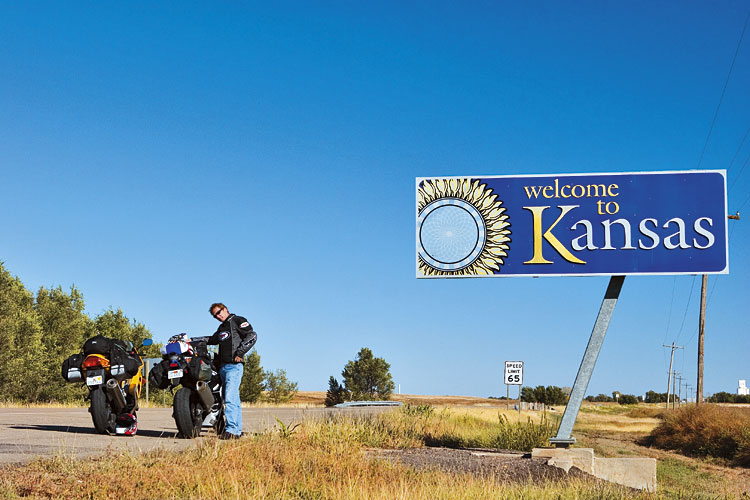Kansas

For motorcyclists, tours on mountain roads have their obvious joys: there's beauty in the scenery and passion in the pavement. When you're riding the serpentines of twisty highways and climbing through passes, every moment on a bike is unavoidably invigorating. But having toured so many mountain roads, I came to wonder what a journey would be like in the parts of America that bikers tend to ignore. A place, for instance, like Kansas.
Adding to the possible lunacy of touring a state without a single curved road is doing it on a Suzuki GSX-R1000. Cathy, my riding partner, is perched on a more practical machine, the Honda VFR. I figured that the trick to comfort was a loaded tankbag to lie on. I was right. Without it, I'd now be living in Wichita, having given up the journey and finding work until spring. With it, the Gixxer couldn't be beat.
We enter Kansas from the west, which anchored our perceptions of the state to the bleak, high prairie that foots the Rocky Mountains, rather than the lush plains of the Missouri River. Maybe it appears slightly bleaker than usual because we left in mid-October. Any remnant of ridges was gone long before we reached the border with Colorado, yet there were other changes that don't go unnoticed. The eastern prairie of Colorado is specked with failed communities - the names are still there but the buildings mostly gone, others are just dilapidated, with failed roofs and missing windows. Here and there a village has one last spark of life, a lone house showing signs of someone living off the grid, scavenged parts from nearby buildings nailed to its sides, the grounds around it a graveyard of transportation: trucks, cars, engines, all wrapped in weeds and dead. Reaching to the horizon in every direction, is the great, brown surround of empty prairie.

We ride into Kansas on Route 50/400, the modern, paved version of the Santa Fe Trail, which was the first overland road to the West. From the border east to Dodge City, the Arkansas River defines the route followed by the Santa Fe Trail, and now the Santa Fe Railroad and the improved Routes 50/400. Almost immediately, Kansas proclaims itself with agricultural flourishes. The tiny spots on the map that are failed habitations in Colorado are alive and well in Kansas.
Our first stop is in the small village of Holcomb, about 70 miles from the western border. Holcomb's main street straddles the main line of the Santa Fe Railroad, but the town has no business center, just a few streets, a school, a two-rail railroad crossing, and a few more streets. As in any other village its size in Kansas, by far its largest, tallest, most-imposing building is the grain silo next to the tracks. There's no attempt to hide it because it represents the core of the community's economy. It's a monument to the commerce it facilitates.

We're in Holcomb on the same mission every other visitor who isn't from Kansas has. You're either in Holcomb to post a letter and pick up the kids from school, or you're there to gawk at the site of a meaningless murder. But like so many other arbitrary crimes across America, the one that befell the Clutter family of Holcomb in 1959 would now be all but forgotten to folklore were it not for Truman Capote and his book, In Cold Blood. Seeing Holcomb, I knew at once the town had long since moved on from the crime - just not from the book. Our being there is enough evidence of that. Worldwide, Capote is famous. In Holcomb, he's infamous.
